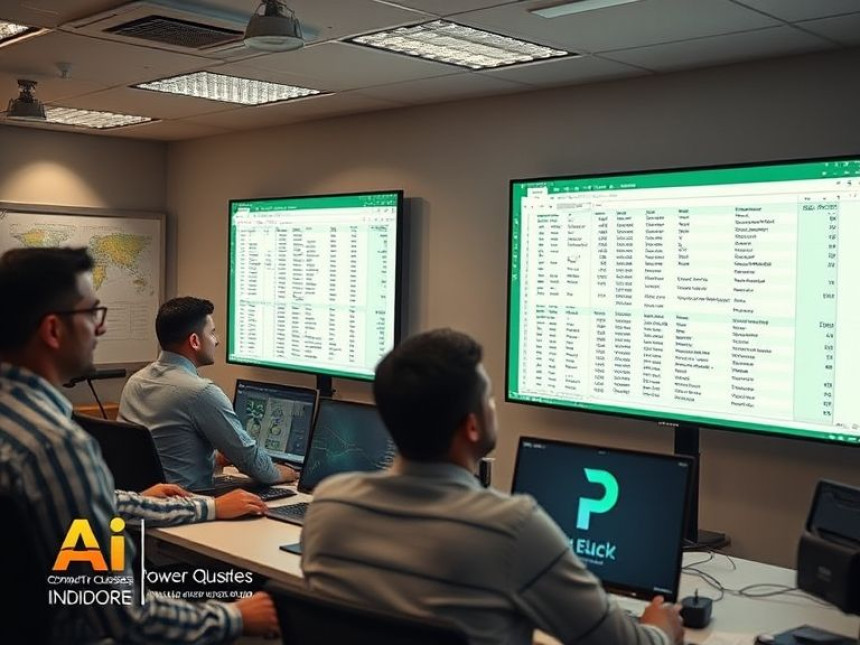
Blockchain Basics: How Distributed Ledgers Work — Tips & Tricks using Excel
Blockchain Basics: How Distributed Ledgers Work — Tips & Tricks using Excel. Get practical lessons and hands-on examples at AI Computer Classes in Indore to master blockchain skills quickly. This article from AI Computer Classes Indore breaks down blockchain basics: how distributed ledgers work — tips & tricks using Excel into actionable steps. Follow practical exercises and tool-based examples to learn rapidly. Includes references to tools like ChatGPT, Power BI, Excel, Figma, or Python where appropriate.
Blockchain Basics: How Distributed Ledgers Work — Tips & Tricks using ExcelBlockchain is one of the most revolutionary technologies of our time — changing how businesses, banks, and even governments store and share data. But to truly understand blockchain, you don’t need to be a programmer — you just need the right tools and visualization methods.
In this guide by AI Computer Classes – Indore, you’ll learn how distributed ledgers work, how to simulate blockchain transactions using Excel, and how you can explore its applications using ChatGPT, Python, and Power BI.
Let’s dive in! 🚀
A distributed ledger is a shared database that exists across multiple systems or locations.
Unlike traditional databases that are centralized, distributed ledgers:
- Store identical copies of data across multiple nodes (computers)
- Use consensus mechanisms to validate transactions
- Make tampering nearly impossible without being detected
Imagine a shared Excel sheet that records every transaction between users. Everyone has a copy, and if one person changes a value, everyone else sees it — unless all agree, that change won’t be accepted.
That’s the basic principle of blockchain!
💡 Learn from Experts at AI Computer Classes – Indore!
Boost your career with hands-on training in Blockchain, AI, and Data Science.
👉 Join our latest batch now at AI Computer Classes
📍 Located in Old Palasia, Indore
🧩 How Blockchain Uses Distributed LedgersEvery blockchain is essentially a distributed ledger that stores transactions in blocks.
Each block contains:
- Transaction data
- A timestamp
- A hash (digital fingerprint)
- The hash of the previous block
This creates a chain of blocks that can’t be modified — making blockchain highly secure.
You can visualize this structure easily using Excel formulas.
Let’s create a mini blockchain ledger using Excel to understand how it works:
Step 1: Create ColumnsBlockTransactionTimestampPrevious HashCurrent Hash
Step 2: Add Example Transactions| 1 | Alice → Bob (₹500) | 10:00 AM | 0000 | =HASH("AliceBob500") |
| 2 | Bob → Charlie (₹200) | 10:10 AM | (Hash of Block 1) | =HASH("BobCharlie200") |
Step 3: Link HashesEach block’s Previous Hash should match the Current Hash of the previous block.
If you modify one transaction, the entire chain breaks — proving immutability.
🔍 Why Distributed Ledgers Are More SecureDistributed ledgers eliminate single points of failure because:
- Each participant has a verified copy of the ledger
- Consensus mechanisms (like Proof of Work or Proof of Stake) verify entries
- Cryptographic hashing ensures data integrity
In Excel, this can be shown by:
- Using formulas to check hash mismatches
- Applying conditional formatting to flag altered entries
💡 Hands-On Tip:
Use Excel’s HASH() or MD5() simulation formulas with cell references to link data across blocks.
This helps visualize how small data changes trigger hash mismatches — the core of blockchain immutability.
⚙️ Using ChatGPT to Explore Blockchain LogicChatGPT can help you:
- Generate pseudo-code for blockchain simulations
- Explain hashing algorithms (like SHA-256) in plain English
- Create Excel macros that simulate mining and validation
Example Prompt:
“Create an Excel VBA macro to simulate blockchain hash validation for 10 blocks.”
ChatGPT will return code you can copy into your Excel workbook for interactive blockchain demos.
💡 Learn from Experts at AI Computer Classes – Indore!
Explore Blockchain concepts hands-on with guided Excel, Python, and Power BI exercises.
🚀 Enroll today at AI Computer Classes
🧮 Visualizing Blockchain Data in Power BIOnce you’ve simulated your blockchain ledger in Excel, you can import it into Power BI to create visual dashboards:
- Timeline charts of transaction flow
- Block validation graphs
- Data consistency visuals using Power Query
Create a heatmap showing block integrity — green for valid, red for tampered — to demonstrate how blockchain ensures trust.
With Python, you can take your Excel blockchain simulation further:
- Use hashlib to generate real SHA-256 hashes
- Store transactions as dictionaries
- Append new blocks programmatically
Example Code:
import hashlib
import time
def create_block(data, prev_hash='0'):
timestamp = str(time.time())
block_hash = hashlib.sha256((data + prev_hash + timestamp).encode()).hexdigest()
return {'data': data, 'timestamp': timestamp, 'prev_hash': prev_hash, 'hash': block_hash}
This script mimics how each new block links securely to the previous one — the essence of distributed ledgers.
Distributed ledger technology (DLT) is used in multiple sectors today:
- Banking: Cross-border payments and transaction auditing
- Healthcare: Secure patient record sharing
- Education: Tamper-proof certificates
- Supply Chain: Tracking products from source to store
AI Computer Classes in Indore teaches these applications through project-based learning, ensuring students build industry-ready blockchain solutions.
Understanding distributed ledgers is the foundation of blockchain mastery.
By simulating blockchain in Excel, visualizing in Power BI, and experimenting with Python, you’ll grasp how data immutability and decentralization ensure trust in digital transactions.
Keep learning, experimenting, and exploring with AI Computer Classes – Indore, your go-to destination for Blockchain, AI, and Data Science education.
📞 Contact AI Computer Classes – Indore
✉ Email: hello@aicomputerclasses.com
📱 Phone: +91 91113 33255
📍 Address: 208, Captain CS Naidu Building, near Greater Kailash Road, Opp. School of Excellence For Eye, Old Palasia, Indore, Madhya Pradesh 452018
🌐 Website: www.aicomputerclasses.com

Use TradingView to Backtest Strategies — Practical Guide with Power BI
Use TradingView to Backtest Strategies — Practical Guide with Power BI. Get practical less...



